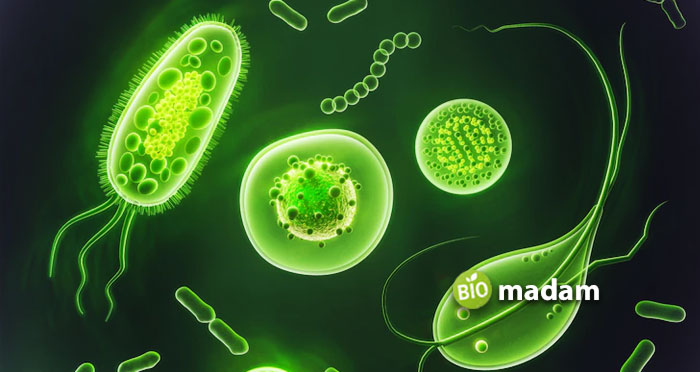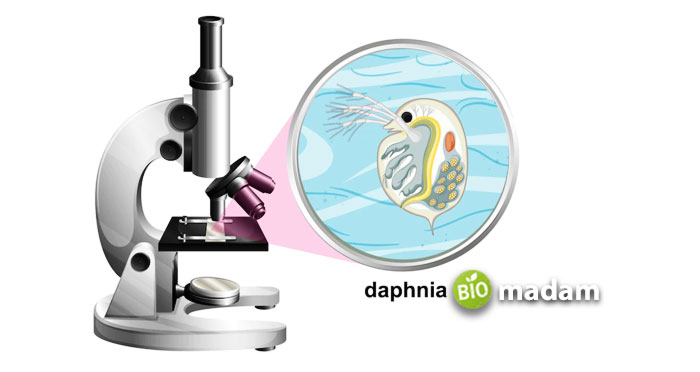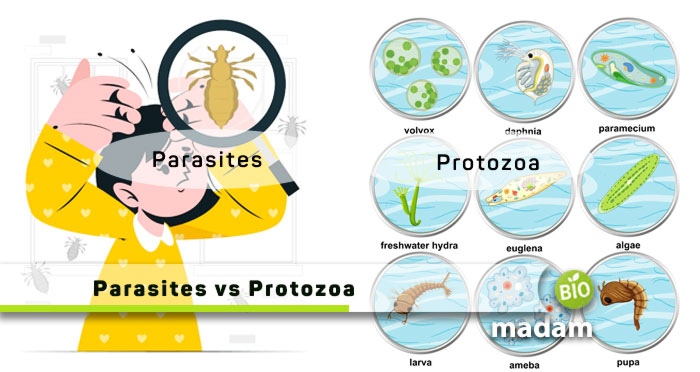Parasites and protozoans are common terms you must have heard in microbiology, but do not confuse both. The protoza and parasite differences are studied in detail under compound and electron microscopes to understand their role in pathology. These are the disease-causing entities that lead to pathological conditions in plants and animals. Even if you previously thought that all protozoa are parasites – that is not true! Both of these tiny organisms are a part of different types of biodiversity and contribute to the overall function of ecosystems.
Keep reading to learn the differences between parasites and protozoa.
Comparison Table
| Factors | Parasite | Protozoa |
| Definition | Disease-causing organisms | Unicellular eukaryotic |
| Types | Ecto, endo, and mesoparasites | Mastigophora, Sarcodina, Sporozoa, and Ciliophora |
| Need for Host | Yes | Not necessary |
| Symptoms | Diarrhea, vomiting, body ache, rashes | Acute diarrhea, abdominal distension, and anorexia |
| Diagnosis | Endoscopy, X-ray, MRI, colonoscopy | Urine analysis, fecal, and CSF testing |
| Treatment | antibiotics | Anti-malarial |
What are Parasites?
Parasites are disease-causing organisms that depend on another living organism for survival.
The word ‘parasite’ comes from a Greek word translating to ‘the one that eats at the table of others.’
Typically parasites are eukaryotic organisms. However, bacteria and viruses may sometimes be considered parasites as they cause infections and diseases.
The organism in which the parasite resides and depends on survival is the host. They obtain micro and macronutrients from the host according to their needs. As parasites need the host to live and multiply, they do not kill the host. However, sometimes the diseases caused by parasites may be fatal.
Parasites may range from single-celled, eukaryotic, small organisms to worms over 30 meters in length.

Types of Parasites
There are three classes of parasites that cause disease in living organisms, namely: protozoa, helminths, and ectoparasites.
These three classes may also be categorized as ectoparasites, endoparasites, and mesoparasites. They are:
Endoparasites
Endoparasites and endoparasites are sometimes confused with endotoxins and exotoxins, while they are entirely different. Endoparasites refer to organisms that attach to the internal surfaces of the body. They are often found in kidneys, both lungs, and blood cells.
Hookworms and parasites like Plasmodium falciparum are examples of endoparasites.
Ectoparasites
Ectoparasites are present on the outer surface of the parasites. They are usually visible on the outer side of the plant, animal, or fungi.
Head lice are a common example of ectoparasites that survive on human blood.
Mesoparasites
Mesoparasites live partly embedded in the host’s body and are usually found in the external openings. The anterior end of mesoparasites forms an anchoring process. The ear canal is the most accessible site for the entrance of mesoparasites. You can protect yourself by avoiding water in the ear during swimming.
Symptoms of Parasitic Infections
The signs and symptoms of parasitic infections may vary depending on the type of parasite. The symptoms may be similar to other diseases but can help understand the cause.
Some of the common symptoms of parasitic diseases include
- Diarrhea and vomiting
- Abdominal pain
- Weight loss
- Rashes
- Aches in body parts
- Fever
- Allergies
- Weakness
Treatment of Parasitic Infections
Like symptoms, the treatment of parasitic infections also varies according to the causative agent. Some of the widely used treatment regimens for parasites include:
- Ivermectin: Ivermectin is used to eliminate parasitic infections of the small intestines, skin, and eyes. These include scabies and different types of worms. Ivermectin is available in the form of tablets, lotions, and creams.
- Metronidazole: Metronidazole is a type of antibiotic that kills bacterial antigens and pathogens in the reproductive or gastrointestinal tract. Metronidazole is typically used for amebiasis or giardiasis.
- Chloroquine: Chloroquine is used to treat malaria, caused by a unicellular parasite called Plasmodium falciparum, P. Chloroquine is available in the form of tablets.
- Praziquantel: Praziquantel helps paralyze and dissolve tapeworms, so they detach from the intestinal walls. Eventually, they pass out of the body through feces.
What are Protozoans?
Protozoans are defined as single-celled, eukaryotic organisms that are either-free living or parasites.
Over 65,000 species of protozoans are known to humankind and spread in different ecosystems and communities. They have a properly organized structure and lack a cell wall. Thus, they are heterotrophs and feed on nutrients from other organisms.
The lifecycle of protozoans alters between the proliferative stage and resting cysts. The reproductive stage allows them to multiply and cause disease. The cyst stage provides the ability to survive tough conditions like chemical environments, extreme temperatures, or nutrient-lacking periods.

Types of Protozoans
Protozoans belong to the kingdom Protista of the five-kingdom classification. The thousands of protozoan species are categorized into three main types according to their similar and dissimilar characteristics. The four subphyla of protozoans include Mastigophora, Sarcodina, Sporozoa, and Ciliophora.
Mastigophora
The members of Mastigophora are parasites of free-living organisms. They are also known as flagellated protozoans, as they have flagella for locomotion. Their body is covered with a pellicle or cuticle, and they reproduce by binary fission.
Leishmania and giardia are examples of Mastigophora.
Sarcodina
Subphylum Sarcodina is also known as amoeboids. These organisms live in the sea, freshwater, or moist soil. They lack a definite shape and use pseudopodia for movement. They also exhibit asexual reproduction by cyst formation, binary fission, or budding.
Entamoeba and amoeba are examples of Sarcodinas.
Sporozoa
Sporozoans are endoparasites and live on the surface of living organisms. They reproduce by sporozoite formation. However, sporozoans do not have a specialized organ for locomotion.
Plasmodium and globidium are sporozoans.
Ciliophora
Protozoans belonging to the sub-phylum Ciliophora are aquatic and use cilia for locomotion. These protozoans also have contractile vacuoles and reproduce by transverse division or cysts. Some species of ciliophoran may have tentacles or trichocysts.
Paramecium and Balantidium belong to Ciliophora.
Symptoms of Protozoan Infection
The symptoms of protozoan diseases show within 10 days to three weeks of the infection. Here are the common symptoms you experience during a protozoan infection.
- Short-lasting acute diarrhea
- Nausea
- Greasy stool
- Abdominal distension
- Anorexia
Treatment of Protozoan Infections
Anti-protozoal drugs are used in the treatment of diseases arising from infection by protozoans. These drugs help our immune system kill bacteria. They are categorized into anti-malarial and miscellaneous drugs. Let’s tell you about the treatment options for protozoans.
- Anti-malarials: The anti-malarial class comprises different anti-protozoal treatments used to treat malaria. These drugs include mefloquine, chloroquine, doxycycline, and proguanil with atovaquone.
- Metronidazole and Tinidazole: Metronidazole and tinidazole are antibiotics used in various protozoal disease infections like trichomoniasis and bacterial vaginosis. Tinidazole is more effective with a more favorable side effect profile and a shorter regimen.
- Nifuratel: Nifuratel is an antibiotic and antifungal agent used in various urinary tract and vulvovaginal infections. It is taken orally in the form of tablets to get rid of protozoal infections.
Similarities between Protozoa and Parasite
Even though, you have had explored the parasite vs protozoa, we would like to mention some of their commonalities below:
- Protozoans and parasites are eukaryotic organisms.
- They cause diseases and infections in other eukaryotic living beings.
- Both types of organisms require a host to survive.
Parasite vs. Protozoa – Key Differences
When comparing differences between parasites and protozoa, it is observed that both are separate organisms. So, let’s discuss their distiguishing features individually below:
Definition
Parasite
Parasites are a group of eukaryotic organisms that produce diseases in their host organism.
Protozoa
On the other hand, protozoa are eukaryotic unicellular living beings belonging to the phylum Protozoa.
Types
Parasite
Parasites are categorized into ectoparasites, endoparasites, and mesoparasites.
Protozoa
Similarly, protozoa are classified into four subphyla, including Mastigophora, Sarcodina, Sporozoa, and Ciliophora.
Need for Host
Parasites
Parasites live in or on the host and survive on the nutrients from the host organism.
Protozoa
Protozoans may live in a host or be free-living. Thus, the need for a host is not compulsory for all protozoans.
Taxonomy
Parasites
These organisms can be from any biological kingdom, such as plants, animals, and microscopic organism.
Protozoa
On the contrary, protozoa comes from a specific kingdom called Protista. The Kingdom Protista are the unicellular eukaryotic organisms having a distinct nucleus.
The Extent of Host
Parasites
Parasites can attack a huge population within an ecosystem. The hosts on which parasites attack can be animals, plants, or even human beings.
Protozoa
Similarly, if you’re confused in are protozoa parasites, know that, they are but to an extent! Not all protozoa are parasites, so they have a little limited range of hosts. Most protozoa are seen living freely in aquatic environment.
Movement of these Organisms
Parasites
Parasites can survive anywhere where this is a proper environment given to them. Some parasites, like helminths, are multicellular that have limited movement. These rely on their host to move, so they can spread. However, there are other parasitic organisms, like Plasmodium, that is free to move in the human’s blood.
Protozoa
In contrast, all protozoa are free-living and highly mobile. They have special structures like cilia and flagella that help them move. Specifically speaking, this feature of movement in protozoa also aids in finding prey or seeking for a reliable host.
Symptoms
Parasite
Parasitic infections can be identified by a few symptoms like diarrhea, vomiting, body ache, rashes, and weakness.
Protozoa
Nausea, greasy stool, anorexia, short-lasting acute diarrhea, and abdominal distension indicate protozoan infection.
Diagnosis
Parasite
The presence of parasites is typically diagnosed through a fecal exam, endoscopy, colonoscopy, blood tests, X-ray, or MRI.
Protozoa
Doctors identify the presence of protozoa through urine, faces, bone marrow, and cerebrospinal fluid testing.
Treatment
Parasite
Physicians prescribe chloroquine, metronidazole, albendazole, and ivermectin for parasitic infections.
Protozoa
On the contrary, the most widely used treatments for protozoans include antimalarials, tinidazole, and nifuratel.
How to Prevent Parasitic or Protozoal Infections?
It might be challenging to save yourself from parasitic diseases. However, you can save yourself from the trouble of getting the protozoal diseases by taking care of a few factors:
- Use mosquito repellents in areas with high mosquito population
- Ask about prevalent parasitic diseases in the areas you are traveling to
- Avoid being around areas having stagnant water
- Eat only well-cooked meat and fish
- Only eat bottled water when in a region with prevalent parasitic diseases
The Bottom Line
Parasites and protozoa are present in all biomes and biospheres, and spread several diseases. Protozoa are also considered a type of parasite as they cause diseases in other living organisms. The major difference between parasites and protozoans is the need for a host. Parasites may live in the primary or secondary host throughout their lifecycle. On the other hand, all protozoans do not require a host; some are free-living. Diseases caused by parasites and protozoans are treated through antibiotics, but these drugs can also produce side effects like constipation and stomachache.
FAQs
How are protozoa and parasites similar?
Parasites are organisms that cause diseases in their host organisms. Sometimes, protozoans may also lead to diseases; they are also parasites. They live in the tissues of their host organism.
How do you get rid of parasites?
Treating parasites depends on the type of parasite you are dealing with. In the past, people ate beets, pumpkin seeds, and raw garlic to kill parasites. Other common remedies include pomegranates, carrots, papaya seeds, and honey.
Can your body clear parasites on its own?
Yes, parasites may leave your body on their own after completing their cycle. Sometimes, the immune system also attacks parasites that may otherwise harm you. However, you must consult a healthcare provider to eliminate parasites completely.
What are the symptoms of a protozoa infection?
The most common symptoms of protozoal infection include diarrhea, nausea, anorexia, and greasy stools. The diarrhea may be accompanied by low-grade fever as well.
Is sleeping sickness caused by protozoa?
Human African trypanosomiasis, commonly known as sleeping sickness, is caused by protozoans. They belong to the genus Trypanosoma and are transmitted to humans through tsetse flies. These flies get infected by biting affected humans and then pass on to the protozoan.

Hello, I would like to introduce myself to you! I am Chelsea Rogers, an experienced blog writer for science articles, holding an MPhil degree. My enthusiasm to grab the best knowledge, let it relate to botany, zoology, or any other science branch. Read my articles & let me wait for your words s in the comment section.

